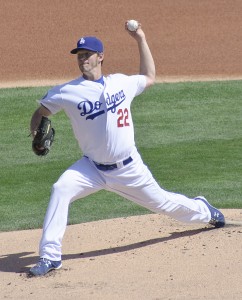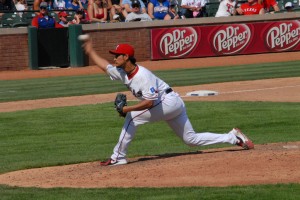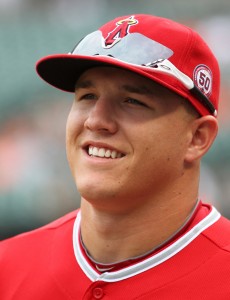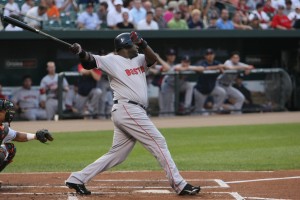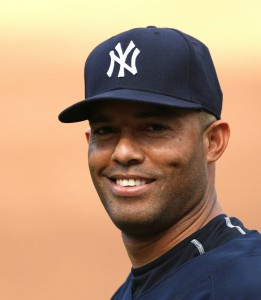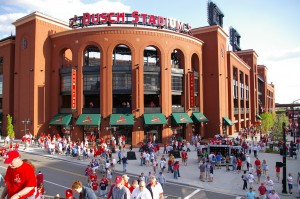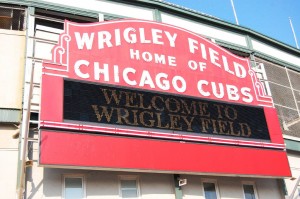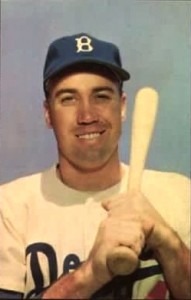As the year ends, BBRT would like to reflect on a few stats and moments that caught my attention during the 2013 baseball season. Some of these have surfaced in these posts in the past, some are new to BBRT’s pages. BBRT hopes they spur a few memories for readers.
Kershaw Gets Season Off to Notable Start.
It may have been April Fools day, but LA Dodgers’ Opening Day Starter Clayton Kershaw was not fooling around – on the mound or at the plate. The eventual Cy Young Award winner held the rival SF Giants scoreless through eight innings. Giants’ hurlers Matt Cain (through six) and George Kontos (seventh), however, had matched him zero-for-zero. Kershaw broke the scoreless tie by leading off the bottom of the eighth with a first-pitch home run off Kontos. Kershaw then went on to complete the four-hit, seven strikeout shutout 4-0.
Not only was the home run Kershaw’s first, and still only, major league round tripper, it made him just the second pitcher in MLB history to toss a shutout and hit a homer on Opening Day. The other was the Indians’ Bob Lemon, who accomplished the feat on April 14, 1953. Lemon, who made the Hall of Fame as a pitcher, threw a one-hitter against the White Sox that day (four walks, three strikeouts). Lemon, who homered in the fourth inning, had an advantage over Kershaw at the plate. Originally a 3B-OF (and the answer to the trivia question“What future HOFer played CF in Bob Feller’s second no-hitter?), Lemon already had 26 MLB homers to his credit and finished his career with 37 round trippers.
Two Homers in an Inning.
Toronto’s Edwin Encarnacion – on July 26 – became the only major leaguer to hit two home runs in one inning during the 2013 season. It came in the seventh inning of a Blue Jays’ 12-6 home win over the Astros. Encarnacion, at DH, hit a solo shot with one out and, as the Jays batted around, added a two-out grand slam.
Encarnacion became the 55th MLBer to go deep twice in an inning – and, for you trivia buffs, only three players have accomplished the feat more than once (twice each): the Giants’ Willie McCovey (1973 & 1977); the Expos’ Andre Dawson (1978 & 1985); and the Pirates Jeff King (1992 & 1996). Encarnacion finished the season with 36 home runs.
The Bash Brothers.
On April 23, B.J. and Justin Upton led off the fifth inning of a 10-2 Braves win over the Rockies (second game of a double header) with back-to-back home runs off Colorado right-hander Jon Garland. That made the Uptons just the second pair of brothers to hit back-to-back MLB homers. The other bashing brothers were the Pirates’ Lloyd and Paul Waner, who accomplished the feat on September 15, 1938, in a 7-2 win over the Giants in New York. It was only the second game in which the Uptons were back-to-back in the Braves’ batting order.
When is a Walk Off Home Run NOT a Walk Off Home Run?
On May 25, Giants center fielder and lead-off hitter Angel Pagan came to the plate in the bottom of tenth with one out, a runner on second and the Giants trailing the visiting Rockies 5-4. Pagan hit a rocket to right-center and raced (not walked) around the bases, sliding across the plate with the winning run. (It was the first inside-the-park “walk-off” homer since 2004.) Unfortunately, Pagan suffered a hamstring injury on the play and ended up having surgery and missing significant time (80+ games) over the rest of the season.
Tough to be YU!
Two guys named YU – The Rangers’ Yu Darvish and Giants’ Yusmiel Petit – both came within one batter of perfect games this season.
On April 2, Darvish was on the mound with two-out in the bottom of the ninth inning, holding a 7-0 lead over the Astros, having retired the first 26 hitters he faced (striking out 14). At the plate was Astros’ shortstop Marwin Gonzalez, who had grounded out and struck out in his first two appearances. Darvish started Gonzalez with a fastball – and the result was a low bouncer that skirted between Darvish’s legs and on into center field for a single. After 111 pitches, Darvish’s night was over and Micheal Kirkman came on to get pinch hitter J.D. Martinez to end the game.
On September 6, Yu number-two – Yusmiel Petit of the Giants – went into the top of ninth inning with a 3-0 lead over the Diamondbacks, having retired the first 24 Arizona hitters, striking out six. He got shortstop Chris Owning with his seventh strikeout, then right fielder Gerardo Parra grounded out second-to-first. That left pinch hitter Eric Chavez between Petit and perfection. Petit got with one strike of a perfect game, only to see Chavez single to right field (just out of the reach of a diving Hunter Pence) on a 3-2 pitch. Chavez and was replaced by pinch runner Tony Campana before Petit induced Diamondback center fielder A.J. Pollock to ground out third-to-first to end the game. The 95-pitch effort was Petit’s first MLB complete game.
Unlikely No-Hitters?
There were three no-hitters thrown in 2013, all by pitchers who started their no-hitters with losing records on the season – and also would finish their seasons with losing records.
On July 2, Reds’ right-hander Homer Bailey – “Homer” seems an unlikely name for a pitcher who tosses a no-no – threw the first no-hitter of the 2013 season. Notably, Bailey also threw the last no-hitter of 2012 (September 28, 2012). His 2013 no-no came in Cincinnati’s hitter-friendly Great American Ballpark, with Bailey shutting down the Giants 3-0 on 109 pitches, walking just one, striking out nine. With the final out, Bailey became just the 31st pitcher to throw multiple no-hitters. Bailey went into the game with a 4-6 record and a 3.88 ERA. He finished the season 11-12, 3.49.
On July 13, the Giants’ Tim Lincecum no-hit the Padres 9-0 in San Diego. The two-time Cy Young winner did not seem a likely candidate to toss a no-hitter that day. Lincecum was coming off a 2012 season in which he went 10-15 with a 5.18 ERA and boasted (wrong word?) a 2013 record of 4-9, 4.61. (He would end the season at 10-14, 4.37.) Lincecum threw a career-high 148 pitches in his no-hit game, striking out 13 batters (while walking four).
On the final day of the season (September 29), the Marlins’ Henderson Álvarez was matched against Detroit’s Justin Verlander – a pitcher much more likely than Alvarez to toss a no-hitter – in Miami. Alvarez came into the season finale with a mark of 4-6, 3.94 (and would finish the season 5-6, 3.59). Alvarez and Verlander matched zeroes across the board and, as the Marlins batted in the bottom of the ninth, Alvarez had completed nine no-hit innings with one walk and four strikeouts. In the bottom of the ninth, Miami turned two singles and a walk into a bases-loaded/one-out situation. Then, with Alvarez on deck, the winning run scored on a wild pitch.
Different Approaches to the Cycle.
Three major leaguers (all outfielders) hit for the cycle in 2013 – and they took significantly different paths to get there.
On May 21, center fielder Mike Trout started slowly in an Angels’ home game against the Mariners, watching a third strike from Aaron Harang. Trout heated up after that with a one-out single in the third inning; a run-scoring triple in the fourth; a bases-loaded/bases-clearing double in the sixth; and a solo, cycle-completing, homer in the eighth. The Angels collected 15 hits in the 12-0 win.
The July 19 Astros/Mariners contest produced the most unexpected cycle of the season – from Houston center fielder Brandon Barnes. Barnes, hitting seventh, got the most difficult legs of his cycle out of the way early. He started with a solo homer in the second; followed with run-scoring triple in the fourth (still the second-year MLBer’s only three-base hit); added a single in the sixth; completed the cycle with a double in the eighth (he later scored); and tossed in another single in the ninth (again scoring). Despite Barnes heroics, the Astros lost 10-7.
On September 23, Rangers’ right fielder Alex Rios completed the cycle in a game that he finished on the bench. Rios started off his day (at Texas against the Astros) with a two-run double in the bottom of the first; added an infield single (and scored a run in the third); hit a solo homer in the fourth; hit an RBI triple in the sixth (and later scored). Rios was replaced by rookie Engel Beltre in right field in the top of the eighth inning, with the Rangers up 12-0.
Big Moments for Big Papi.
On July 10, in the top of the second inning, Boston DH David Ortiz doubled to left off Seattle pitcher Aaron Harang, It was Ortiz’ 1,685th hit as a DH – giving him the all-time record (he passed Harold Baines). The 37-year-old Ortiz had a solid season, .309 with 30 home runs and 103 RBI, before thrilling us all by hitting .688 in the World Series.
Astros Play WHIFF-le ball.
Over the course of the season, the Houston Astros (who finished an MLB-worst 51-111) struck out an all-time MLB record 1,535 times – breaking the Diamondbacks’ 2010 record of 1,529. Why might this be especially notable? Having moved to the American League, the Astros set the new record without the benefit of their pitchers flailing (and failing) at the plate. In 2010, 119 of the Diamondbacks’ record-setting whiffs were credited to pitchers at the plate.
Pirates Make the Post Season.
The Pittsburgh Pirates went 94-68 and made the playoffs after a twenty consecutive losing seasons. By contrast, the Yankees have not had a losing season since 1992 – and have had only 22 losing seasons in the history of the franchise (1901-2013 in Baltimore and NY). The Pirates, led by such players as MVP Andrew McCutchen, speedy tablesetter Sterling Marte, NL HR co-leader Pedro Alvarez, starting pitcher and Comeback Player of the Year Francisco Liriano and relievers Jason Grilli and Mark Melancon were fun to watch in 2013.
The Dodgers’ Remarkable Comeback.
As of July 1, the underachieving Dodgers were in last place in the NL West (38-43, 3 ½ back). Just 80 days later – on September 19 – with a 7-6 win over the Diamondbacks, LA became the first team to clinch a 2013 playoff berth. The Dodgers are just the fourth team (along with the 1914 Boston Braves, 1973 New York Mets and 1995 Seattle Mariners) to finish in first place after holding last place as of July 1 or later.
The comeback is even more remarkable when you consider that on June 21, the then last-place Dodgers stood at 30-42, 12 games under .500 and 9 ½ back of Arizona. From that point, they went 62-28 – finishing 22 games over and 11 games ahead of second-place Arizona.
Old Guys Rule!
BBRT took great pleasure in watching a a group of forty-year olds defy father time.
– Mariano Rivera (age 43) goes 6-2, 2.11 with 44 saves for the Yankees in his farewell season.
– Bartolo Colon (age 40) went 18-6, 2.65 for the A’s, leading the AL in shutouts (3).
– Forty-one-year-old Raul Ibanez hit 29 home runs, tying Ted Williams for the most ever by a 41-year-old. And, his 29th homer of the season was also his career 300th.
– The Indians’ Jason Giambi, at age 42, became the oldest player to hit a walk-off homer.
Young Guys Rule Too!
Mike Trout, Bryce Harper, Wil Myers, Manny Machado, Yasiel Puig, Jose Fernandez, Shelby Miller – and the list goes on an on. There were – and still are – simply a lot of great young stars to watch. For more – and a look at BBRT 2013 Young Star Team click https://baseballroundtable.com/bbrts-2013-mlb-young-star-team-born-in-the-90s/
Chris Davis – newest 50-homer guy.
Chris Davis led all of MLB with 53 home runs and 138 RBI, becoming the 27th player to reach the 50-homer mark. His 53 HRs are the 26th most in an MLB season (for more on the 50 homer club, click https://baseballroundtable.com/chris-davis-newest-member-of-50-homer-club/
The Worst-to-First Boston Red Sox.
In 2012, the Boston Red Sox finished in last place in the AL East, 69-93 and 26 games out. The Sox dumped first-year manager Bobby Valentine and brought in John Farrell. They also made changes to the team during the off-season – changes that didn’t seem to excite analysts or fans. Joining the Red Sox were not the biggest name free agents, but “character and chemistry” players like Mike Napoli, Shane Victorino, Koji Uehara, Stephen Drew, and Ryan Dempster. Preseason, many analysts picked the Sox to finish at or near the bottom of the division. The Red Sox’ strategy paid off as they won the East with a 97-65 record, and went on to win the World Series. Napoli contributed 23 HRs and 92 RBI, Victorino hit .294 with 21 steals, and Uehara notched 21 saves to go with a 1.09 ERA. Red Sox veterans chipped in as well. David Ortiz went .309-30-103; Dustin Pedroia’s line was .301-9-83 (17 steals); John Lester rebounded with a 15-8 record and 3.75 ERA; and, despite injuries that limited him to 16 starts, Clay Bucholz went 12-1, 1.74.
Payroll and Placement.
Looking at the teams that made it into the post-season three of the top five opening day payrolls were there (#2 Dodgers, #4 Boston and #5 Detroit), but so were three of the bottom five payrolls (#26 Pittsburgh, # 27 Oakland, # 28 Tampa). Of note, the Dodgers’ $220 million payroll exceeded the combined opening day payrolls of playoff bound Oakland ($61 million), Pittsburgh ($80 million) and Tampa Bay ($58 million). (Figures from CBSsports.com.)
